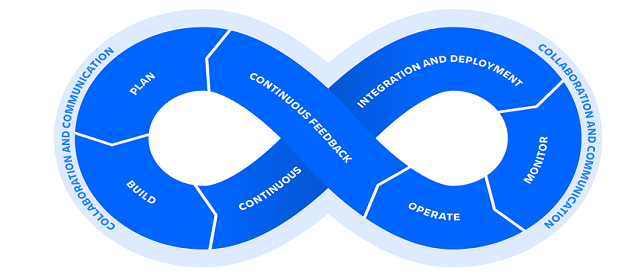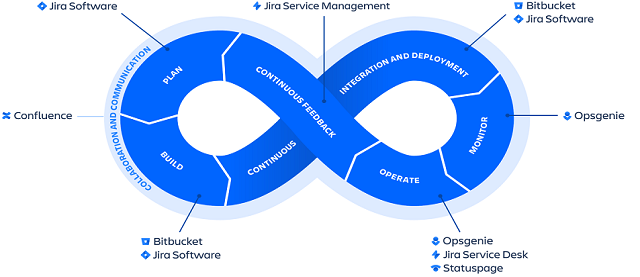Article on DevOps
What exactly is DevOps?

DevOps is a combination of the two terminology development and operations that represents a collaborative or shared method to tasks performed by an organization’s development and operations teams. In another words it can also be described as a set of different tools, practices, and cultural philosophies which further automates and integrate the processes between the software development and infrastructure management. It completely focuses on team growth, team communication and collaboration, and technology automation.
How does DevOps work?
DevOps team consists of developers and IT professionals working as a team with the product lifecycle, in order to increase the speed and quality of the software deployment. DevOps is a means to improve work throughout the software development lifecycle (SDLC). A DevOps process is a continuous loop that comprises of the following steps: plan, code, build, test, release, deploy, operate, monitor and through feedback plan, which resets the loop.
In DevOps, the IT team writes the software that meets the user requirements (SRS), which gets deployed and runs perfectly on the first go. Nowadays, most of the companies use a combination of the culture and technology to pursue this goal.
To position the software to its expectations, the developers and the stakeholders’ team communicate with each other about the software, and then developers work on the small updates which go live independently of each other.
DevOps team uses various tools to automate processes, which helps to increase reliability. To avoid the wait times, IT team use CI/CD pipelines and some other automation to move code from one development phase to another. Then the team reviews the changes immediately.
DevOps Life Cycle

An infinity loop is used to show the relation between the phases of the DevOps lifecycle where the loop symbolizes the below two things –
- Need for constant collaboration and,
- Iterative improvement throughout the entire cycle.
The lifecycle has six phases that are processes, capabilities, and tools needed for development and operations. From very beginning to end of each phase, the teams discuss and communicate to maintain positioning, quickness, and quality.
Plan: The team should adopt agile practices to improve speed and quality.
Build: GitHub is a free and open source version control system that offers support for branching, merging, rewriting repository history, which leads to many innovative and powerful workflows and tools for the development build process.
Continuous Integration / Continuous Delivery (CI/CD): These are development processes that involve frequent code changes being published to the source code repository while ensuring it is not causing any issues due to simultaneous changes being made by developers working in parallel.
Monitor and Alert: It provides automation and explained measurement and visibility throughout the entire development lifecycle and quickly identifies and resolve issues that impact product uptime, speed, and functionality and notifies the team of changes, high-risk actions, or failures, so you can keep services on.
Operate: It involves maintaining, monitoring, implementation, configuration, deployment, and troubleshooting applications in production environment.
Continuous Feedback: It evaluates each release on the user experience and then generates reports to improve future releases.
DevOps Tools

DevOps tools show the key phases of the DevOps lifecycle. It helps to improve collaboration, reduce context-switching, introduce automation, and enable observability and monitoring.
DevOps Methods
The common DevOps methods that organizations can use to speed and improve development process are Agile, Scrum, Kanban etc.
Agile: Agile is an iterative approach to project management and software development that is time boxed, iterative approach to software delivery that helps team deliver value to their customers faster and with fewer headaches. It first breaks down the project into different bits of user functionality called user stories, prioritizing them, and then continuously delivering them in short two week cycles known as iterations.
Scrum: Scrum defines how members of a team should collaborate while working on development and QA projects. Scrum practices include key workflows and terminologies like sprint, release, daily scrum, etc.
Kanban: It is derived from the efficiencies gained on the Toyota factory floor. Kanban defines a way for tracking the status of the different work items in a project using a kanban board.
Benefits of DevOps
The benefits of DevOps include:-
- Faster issue resolution and reduced complexity
- Faster, better product delivery
- Greater scalability and availability
- More stable operating environments
- Better resource utilization
- Greater automation
- Greater visibility into system outcomes
- Greater innovation
DevOps Practices
The following are DevOps best practices:
Continuous Development: Continuous development is a practice that spans the planning and coding phases of the DevOps lifecycle.
Continuous Integration: Continuous integration is a practice that brings configuration management tools together with other test and development tools to track the amount of code developed and how much is ready for production. It also involves rapid feedback between testing and development team to quickly identify and resolve code issues.
Continuous Delivery: Continuous delivery is a practice that automates the delivery of the code, after testing is done, to a preproduction or staging environment. After its proper implementation, developers will always have a deployment-ready build artifact that has passed through a standardized test process.
Continuous Deployment: Continuous deployment is a practice that automates the release of new or changed code into production. Companies doing continuous deployment might release code or feature changes several times per day.
Infrastructure As a Code: Infrastructure as code is a practice that is used to automate the provisioning of infrastructure required for a software release at various DevOps phases. The developers then add infrastructure code from their existing development tools.
Monitoring and Logging: Monitoring & Logging is a practice which involves ongoing monitoring of both the code in operation and the underlying infrastructure that supports it. A feedback loop is created that reports on bugs or issues then makes its way back to development.
Join Famark Community!
Famark community is a social platform for creative and innovative professionals from different domains.
Join Community